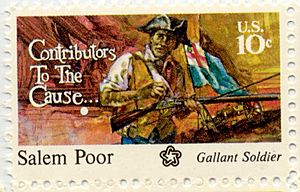Salem Poor facts for kids
Quick facts for kids
Salem Poor
|
|
|---|---|

1975 postage stamp depicting Poor at the Battle of Bunker Hill
|
|
| Born | 1747 Andover, Massachusetts |
| Died | 1802 (Aged 55) Boston, Massachusetts |
| Allegiance | United States |
| Service/ |
Massachusetts Militia |
| Years of service | 1775-1780 |
| Battles/wars | |
Salem Poor (born 1747, died 1802) was an African-American man who was once enslaved. He bought his freedom in 1769 and became a brave soldier in the American Revolutionary War. He is especially famous for his heroic actions at the Battle of Bunker Hill.
Contents
Early Life of Salem Poor
Salem Poor was born in 1747. He was born into slavery on a farm in Andover, which was then part of the Province of Massachusetts Bay. The farm belonged to John Poor and his family.
On July 10, 1769, Salem Poor bought his freedom from John Poor Jr. He paid £27, which was a large sum of money at the time. This amount was like a whole year's salary for an average worker. Today, that would be worth about $5,600.
Military Career in the Revolution
In May 1775, when he was about 28 years old, Salem Poor joined the militia. He served under Captain Benjamin Ames in Colonel James Frye's group of soldiers. His group, along with two others, had 850 soldiers in total.
They marched from Cambridge to Charlestown, Massachusetts. There, the officers decided to build a fort on top of Breed's Hill. The soldiers worked quickly and quietly. They wanted to make sure the British army in Boston did not know they were there.
Fighting at Bunker Hill
Salem Poor was one of many African Americans who fought in the Battle of Bunker Hill on June 17, 1775. About three dozen African Americans fought on Bunker Hill. In total, around 5,000 free and enslaved African Americans fought for the American Patriots. Meanwhile, about 20,000 to 30,000 black soldiers fought for the British.
The British army was twice the size of the American forces. They attacked Breed's Hill on June 17, 1775. The Americans pushed the British back twice. However, they ran out of ammunition and had to retreat during the third attack.
Poor is best known for his actions during this battle. He was credited with seriously wounding British Lieutenant Colonel James Abercrombie. Abercrombie was yelling, "Surrender, you rebels!" as he jumped onto the American fort. Some people believe Abercrombie might have been hit by friendly fire instead.
Artist John Trumbull later created a famous painting. It showed the death of American General Joseph Warren and British Lieutenant Colonel James Abercrombie.
Recognized for Bravery
Salem Poor's courage at the Battle of Bunker Hill impressed many. Fourteen officers, including Colonel William Prescott, praised him for his heroism. They sent a special request to the General Court of Massachusetts.
Their statement said: "We declare that a Negro Man Called Salem Poor... behaved like an Experienced Officer, as Well as an Excellent Soldier. To Set forth Particulars of his Conduct would be Tedious, We Would Only beg leave to say in the Person of this Negro Centers a Brave & gallant Soldier."
This means they saw him act like a skilled officer and a great soldier. They believed he was a very brave and heroic soldier. There is no record that Poor received a special reward for this.
Changes in Army Rules
At first, on July 10, 1775, George Washington stopped recruiting African Americans. On November 12, he even ordered that no black men could serve in the Continental Army. However, those who were already serving were allowed to stay for a while.
When Lord Dunmore, the Governor of Virginia, heard this, he made an offer. He offered freedom to all enslaved people who would fight for the British. Washington quickly realized this was a problem. He immediately changed his mind and ordered recruiters to enlist any black men who wanted to fight.
Later Service
Salem Poor continued to serve in the war. He was known to have spent a winter at Valley Forge. He also fought in several important battles. These included the Battle of White Plains, the Battle of Saratoga, and the Battle of Monmouth. He also served at Fort George.
In 1776, Salem Poor served in New York under General Benedict Arnold. He later joined the militia again for three years. He spent time in Saratoga. From 1777 to 1778, he was at Valley Forge and fought in the Battle of White Plains. Poor continued fighting with the American forces until March 20, 1780. He was then discharged in Providence, Rhode Island.
Personal Life and Family
In August 1771, Salem Poor married Nancy Parker. She was described as a "part Indian servant." They had a son named Jonas, who was baptized in September 1776.
In 1780, he married his second wife, Mary Twing. She was a free African American woman. The couple moved to Providence. Salem Poor married two more times later in his life.
Death and Legacy
Salem Poor died in 1802 when he was 55 years old. He was buried at Copp's Hill Burying Ground near Boston, Massachusetts. For many years, not much was known about his life after the Revolutionary War. However, new research in 2007 helped bring his story to light.
Honors and Recognition
The officers who praised Salem Poor in 1775 suggested he receive a special reward. This request was made on December 5, 1775.
In 1876, during the United States' 100th birthday celebration, George Washington Williams honored Poor. He spoke about Poor and other African-American soldiers who fought at Bunker Hill.
For the 200th birthday of the United States in 1976, Salem Poor was honored with a postage stamp in 1975. This stamp was part of a series called "Contributors to the Cause." A street in Andover, Massachusetts, was also named Poor Street after him.

